Explore Botswana’s finest National Parks during this safari. Start your tour by experiencing Marakele National Park, Khama Rhino Sanctuary and the Makgadikgadi Pans. See giraffe, elephant, zebra, lion and wildebeest in the Moremi Game Reserve and Khwai area from your own 4x4 vehicle. Discover the Okavango Delta in traditional dug-out canoes and enjoy Chobe National Park’s wildlife on a boat cruise on the Chobe River.
Departs: Johannesburg, South Africa.
Ends: Victoria Falls, Zimbabwe.
Group size: Guaranteed from 4 guests; 12 guests maximum. *Certain departures guaranteed with no minimum pax available.
Summary
A small group lodge safari, from Johannesburg to Victoria Falls through South Africa, Botswana and Zimbabwe.
Highlights
Marakele National Park, Khama Rhino Sanctuary, Nxai Pan, Moremi National Park, Khwai River area game drive and night drive, Okavango Delta experience including Mokoro excursion, Chobe National Park game drive, River cruise on the Chobe River, Victoria Falls.
Meals
12x Breakfast, 9x Lunch, 8x Dinner. Where included most breakfasts and dinners will be enjoyed in the restaurants of the various accommodation establishments, however on certain nights the guide will provide an authentic meal for the group, which will be enjoyed together in the evening, often around a camp fire. Please advise us of any special dietary requirements in advance.
SAFARI
COST: $3,355 per person sharing, plus local payment of ZAR 1,150 (in cash).
SINGLE SUPPLEMENT: $1,010 |
CLICK TO SEE DEPARTURE DATES
|
|
DAY 1;
(1 Night)
JOHANNESBURG, South Africa [Lodge] |
On arrival in Johannesburg, you will be met and transferred to the Safari Club. You have
the remainder of the day at leisure. This evening you will meet your guide and the rest of
the group for your pre-departure meeting at 6pm. |
Departure: n/a
Distance: n/a
Overnight: Safari Club or similar (rooms with en-suite bathrooms,
swimming pool and restaurant).
Meals: Lunch and Dinner at your own account.
|
DAY 2;
(1 Night)
JOHANNESBURG TO MARAKELE, South Africa [Rooms or Chalets] |
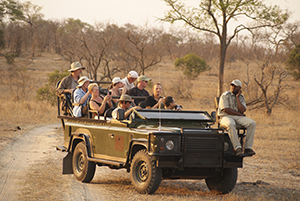 An early morning departure from The Safari Club in Johannesburg takes us via Pretoria, Thabazimbi and through the Limpopo Province to Marakele National Park in the heart of the Waterberg Mountains. All the large game species from Elephant and Rhino to the big cats as well as an amazing variety of birds including the largest colony of endangered Cape Vultures in the world, have settled here. An early morning departure from The Safari Club in Johannesburg takes us via Pretoria, Thabazimbi and through the Limpopo Province to Marakele National Park in the heart of the Waterberg Mountains. All the large game species from Elephant and Rhino to the big cats as well as an amazing variety of birds including the largest colony of endangered Cape Vultures in the world, have settled here.
We will head out on a sunset game drive in the evening of day 2. We will enjoy our evening meal prepared by our guide around the campfire before spending our first night in the African wilderness. |
Departure: 9:00am
Distance: 290 kms
Overnight: Tlopi Tented Camp or similar (permanent tents with en-suite bathrooms).
Meals: Breakfast at Safari Club or similar, Lunch prepared by guide, Dinner at Stevensford Game Reserve or similar.
|
DAY 3;
(1 Night)
MARAKELE TO KHAMA RHINO SANCTUARY, Botswana [Hotel] |
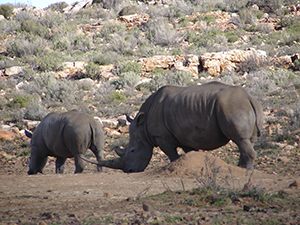 Our destination today is the Khama Rhino Sanctuary via the Martin’s Drift border post. The Khama Rhino Sanctuary Trust is a community based wildlife project, established in 1992 to assist in saving the vanishing white rhino, restore an area formerly teeming with wildlife to its previous natural state and provide economic benefits to the local Batswana community through tourism and the sustainable use of natural resources. Our destination today is the Khama Rhino Sanctuary via the Martin’s Drift border post. The Khama Rhino Sanctuary Trust is a community based wildlife project, established in 1992 to assist in saving the vanishing white rhino, restore an area formerly teeming with wildlife to its previous natural state and provide economic benefits to the local Batswana community through tourism and the sustainable use of natural resources.
We explore the sanctuary on an afternoon game drive in search of white rhinos. |
Departure: 8am
Distance: 380 kms
Overnight: Serowe Hotel or similar (rooms with en-suite bathrooms, swimming pool, bar & restaurant area).
Meals: Breakfast prepared by guide, Lunch prepared by guide, Dinner on your own account.
|
DAY 4;
(1 Night)
KHAMA RHINO SANCTUARY TO PLANET BOABAB, Botswana [Huts] |
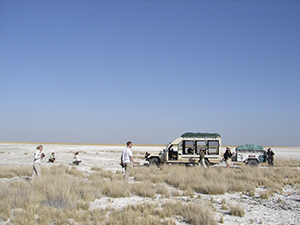 Today we travel towards the Makgadikgadi Pans National Park area of Botswana. After settling into our accommodation, we take a stroll with our guide through the surrounding baobab grove. He will explain the local ecology, geology and the unique biology of the baobabs, which are in fact not trees but the largest succulents in the world. Today we travel towards the Makgadikgadi Pans National Park area of Botswana. After settling into our accommodation, we take a stroll with our guide through the surrounding baobab grove. He will explain the local ecology, geology and the unique biology of the baobabs, which are in fact not trees but the largest succulents in the world.
|
Departure: 7am
Distance: 467 kms
Overnight: Planet Baobab or similar (Bakalanga or Baobab huts with en-suite bathrooms).
Meals: Breakfast at Serowe Hotel or similar, Lunch prepared by guide, Dinner at Planet Baobab or similar.
|
DAY 5; (1 Night)
PLANET BOABAB TO MAUN, Botswana [Tented Camp] |
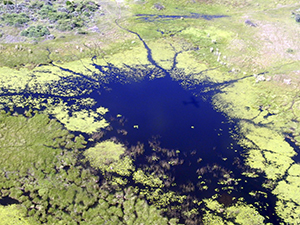 This morning we head off to Maun, the gateway to the Okavango Delta. Enroute we travel via Nxai Pan, a fossil lake that is part of the greater Makgadikgadi system. Covered in nutritious short grasses and small islands of acacia trees, Nxai Pan attracts vast numbers of desert herbivores as well as carnivores including lion, leopard, cheetah and wild dog. After our Nxai Pan excursion we continue our journey to Maun. The name Maun is derived from the San word “maung”, which means “the place of short reeds”. This morning we head off to Maun, the gateway to the Okavango Delta. Enroute we travel via Nxai Pan, a fossil lake that is part of the greater Makgadikgadi system. Covered in nutritious short grasses and small islands of acacia trees, Nxai Pan attracts vast numbers of desert herbivores as well as carnivores including lion, leopard, cheetah and wild dog. After our Nxai Pan excursion we continue our journey to Maun. The name Maun is derived from the San word “maung”, which means “the place of short reeds”.
|
Departure: 6am
Distance: 215 kms
Overnight: Thamalakane River Lodge or similar (Meru tents with ensuite bathrooms, swimming pool, bar & restaurant).
Meals: Breakfast at Planet Baobab or similar, Lunch prepared by guide, Dinner at your own account. |
DAY 6;
(1 Night)
MAUN TO KHWAI, Botswana [Tented Camp] |
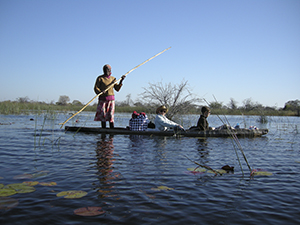 After breakfast we will be picked up by our local Botswana guides and take a short drive
to the mokoro station. From here, we will float in dug-out canoes through the thick vegetation of the Okavango Delta discovering a variety of birds and wildlife. Unlike
other deltas, it flows into the Kalahari Desert without ever reaching the coast. After this
spectacular excursion, we make our way to our camp, which is situated in close
proximity to the famous Khwai River. After settling into our camp, we will enjoy dinner
and embark on a night game drive – a fantastic opportunity to spot some nocturnal
animals that are more difficult to encounter during the day. After breakfast we will be picked up by our local Botswana guides and take a short drive
to the mokoro station. From here, we will float in dug-out canoes through the thick vegetation of the Okavango Delta discovering a variety of birds and wildlife. Unlike
other deltas, it flows into the Kalahari Desert without ever reaching the coast. After this
spectacular excursion, we make our way to our camp, which is situated in close
proximity to the famous Khwai River. After settling into our camp, we will enjoy dinner
and embark on a night game drive – a fantastic opportunity to spot some nocturnal
animals that are more difficult to encounter during the day.
|
Departure: 8am
Distance: 150 kms
Overnight: Khwai Bedouin Camp or similar (permanent tents with en-suite bathrooms). Please note that there is no electricity at camp.
Meals: Breakfast at Thamalakane River Lodge or similar, Lunch prepared by guide, Dinner at Bedouin Bush Camp or similar.
|
DAY 7; (1 Night)
KHWAI RIVER, Botswana [Tented Camp] |
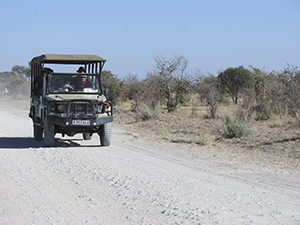 We have the opportunity to spend the day on game drives. In our open 4x4 vehicle we will explore the Khwai River area on morning and afternoon game drives hopefully spotting a variety of game that frequent this region. This large area is renowned for its concentration of mammals and it is not unusual to see many different types of wildlife during just one game drive. We have the opportunity to spend the day on game drives. In our open 4x4 vehicle we will explore the Khwai River area on morning and afternoon game drives hopefully spotting a variety of game that frequent this region. This large area is renowned for its concentration of mammals and it is not unusual to see many different types of wildlife during just one game drive.
Game viewing is seasonal; depending on the time of the year you may see different species in different areas. The best time for game viewing is the end of the dry season or spring from August to November. During this season, in order for us to offer the best game viewing possible, extra driving may be required due to the animals migrating closer to the river. In the summer, birdlife can also be viewed in abundance with exceptional sightings of wildfowl and raptors. |
Departure: 7am
Distance: 150 kms
Overnight: Khwai Bedouin Camp or similar (permanent tents with ensuite bathrooms).
Meals: Breakfast at Bedouin Camp or similar, Lunch pack from Bedouin Camp or similar, Dinner at Bedouin Camp or similar.
|
DAY 8; (1 Night)
MOREMI GAME RESERVE, Botswana [Tented Camp] |
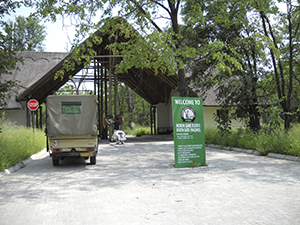 After having explored the Khwai area we now head into the famous Moremi Game
Reserve known as one of the most beautiful and varied reserves in Africa with an
unprecedented concentration of wildlife. The full day is spent in the unspoiled nature of
the Moremi Game Reserve which is home to a great diversity of plant and animal life - making it a 'must see' for a Botswana Safari. It contains - within its boundaries - approximately 20% of the Delta, and a vast range of habitats, acacia forests, floodplains,
reed beds, lagoons, enduring wetland through mopane forest and dry savanna
woodland. After having explored the Khwai area we now head into the famous Moremi Game
Reserve known as one of the most beautiful and varied reserves in Africa with an
unprecedented concentration of wildlife. The full day is spent in the unspoiled nature of
the Moremi Game Reserve which is home to a great diversity of plant and animal life - making it a 'must see' for a Botswana Safari. It contains - within its boundaries - approximately 20% of the Delta, and a vast range of habitats, acacia forests, floodplains,
reed beds, lagoons, enduring wetland through mopane forest and dry savanna
woodland.
|
Departure: 7am
Distance / Time: 120kms
Overnight: Khwai Bedouin Camp or similar (permanent tents with ensuite bathrooms).
Meals: Breakfast at Bedouin Camp or similar, Lunch pack from Bedouin Camp or similar, Dinner at Bedouin Camp or similar. |
DAY 9; (1 Night)
KHWAI RIVER TO CHOBE NATIONAL PARK, Botswana [Tented Camp] |
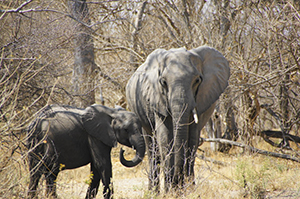 We have to get up early, as there is another exciting day ahead of us! We leave the camp in Khwai River and transit through the national parks of Moremi, Savuti and Chobe to Kasane, the gateway to the Chobe National Park. Keep an eye out for the wildlife in this area. Our lodge is situated on the bank of the Chobe River a short distance from its confluence with the mighty Zambezi River at Kazungula. We have to get up early, as there is another exciting day ahead of us! We leave the camp in Khwai River and transit through the national parks of Moremi, Savuti and Chobe to Kasane, the gateway to the Chobe National Park. Keep an eye out for the wildlife in this area. Our lodge is situated on the bank of the Chobe River a short distance from its confluence with the mighty Zambezi River at Kazungula.
|
Departure: 7am
Distance / Time: 165 kms
Overnight: Chobe Safari Lodge or similar (rooms with en-suite bathrooms, swimming pool, bar & restaurant).
Meals: Breakfast at Khwai Bedouin Camp or similar,
Lunch prepared by the guide,
Dinner at Chobe Safari Lodge or similar. |
DAY 10; (1 Night)
CHOBE NATIONAL PARK, Botswana [Tented Camp] |
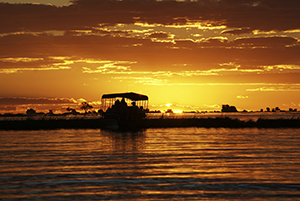 We start the morning with an exciting game drive in the Chobe National Park, which along with many species of big game, boasts the largest concentration of elephant in Africa. We enjoy a boat cruise on the Chobe River in the afternoon from where we can watch elephants, hippos, crocodiles and a variety of birds without having to reach for our binoculars – you'll be near enough for close-up photographs, as well as having the chance to witness a spectacular African Sunset. We start the morning with an exciting game drive in the Chobe National Park, which along with many species of big game, boasts the largest concentration of elephant in Africa. We enjoy a boat cruise on the Chobe River in the afternoon from where we can watch elephants, hippos, crocodiles and a variety of birds without having to reach for our binoculars – you'll be near enough for close-up photographs, as well as having the chance to witness a spectacular African Sunset.
|
Departure: 7am
Distance / Time: 100 kms
Overnight: Chobe Safari Lodge or similar (rooms with en-suite bathrooms, swimming pool, bar & restaurant).
Meals: Breakfast at Chobe Safari Lodge, Lunch at own account, Dinner at Chobe Safari Lodge.
|
DAY 11 - 12; (2 Nights)
CHOBE NATIONAL PARK TO VICTORIA FALLS, Zimbabwe [Chalets] |
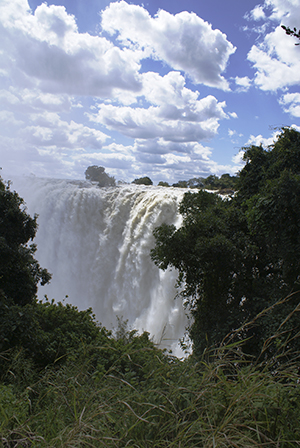 Our journey takes us into Zimbabwe, home to one of the seven natural wonders of the world, the mighty Victoria Falls. We have the opportunity to view the falls on a guided tour through the Victoria Falls National Park. You have the rest of the day and the next day at leisure to partake in one of the many activities on offer. Our journey takes us into Zimbabwe, home to one of the seven natural wonders of the world, the mighty Victoria Falls. We have the opportunity to view the falls on a guided tour through the Victoria Falls National Park. You have the rest of the day and the next day at leisure to partake in one of the many activities on offer.
|
Departure: 9am
Distance / Time: 95 kms
Overnight: A’Zambezi River Lodge or similar (rooms with en-suite bathrooms, swimming pool, bar & restaurant).
Meals Day 11: Breakfast at Chobe Safari Lodge or similar, Lunch prepared by guide, Dinner at your own account.
Meals Day 12: Breakfast at A'Zambezi River Lodge or similar, Lunch at your own account, Dinner at The Boma Place of Eating or similar. |
DAY 13;
VICTORIA FALLS, Zimbabwe [TOUR ENDS] |
Your journey ends today and you will be transferred to Victoria Falls Airport in time for
your departing flight. We hope to welcome you again one day on another of our African
adventures. |
Departure: N/A
Distance / Time: N/A
Overnight: N/A
Meals: Breakfast at A'Zambezi River Lodge, Ilala Lodge or similar.
|
Note: The accommodation specified in the itinerary is a guide only and is subject to availability. Alternatives will be nearby and of a similar standard.
 Top Top
CLICK TO SEE DEPARTURE DATES
Included
Accommodation as mentioned in the itinerary, transport on day 2-5 and 11-12 in a closed vehicle, transportation for remainder of the safari in an open fully kitted 4x4 safari vehicle, game drives as mentioned, meals and activities as mentioned in itinerary, park entrance fees, experienced local guide.
Excluded
Travel insurance, flights, pre and post tour accommodation, optional activities, all drinks, telephone calls, gratuities, curios and all personal expenses.
Departure
The Botswana Untouched Lodge Safari departs from the Safari Club in Johannesburg.
Please note that the daily departure times are a guideline only and are subject to change due to seasonal variations, as well as unforeseen circumstances. The final decision rests with your guide who will advise you at what time you will be departing each day.
On the evening of day one, there will be a meeting presented by your guide, at 18h00, at the Safari Club. It is imperative that all clients attend this meeting so as not to miss out on any critical information. Whilst it is our every intention to adhere to the above mentioned itinerary, there may on occasion be a necessity to make alterations in order to make the tour more enjoyable or practical. Therefore please treat the itinerary as a guide only.
Transport
You will be transferred from Johannesburg to Maun in a closed vehicle. From here your journey will continue in a fully equipped open sided Land Cruiser or other appropriate vehicle with comfortable seating for maximum game viewing. An off-road trailer is fitted with a field kitchen. All luggage, besides hand luggage and photo equipment, is carried on the vehicle or trailer roof racks to ensure maximum comfort in the vehicle. For transfers between Kasane and Victoria Falls (or vice versa), 2x4 vehicles may be utilised.
Local Payment
A local payment is required on your safari and will be collected by your guide on the day of departure. The local payment is part of the overall tour cost and is used to pay some of the day to day operational costs that are incurred while we are on the road. We try to prepay as many of the costs as possible however in some cases cash payment on arrival is the only option as some of the attractions we visit on safari only accept cash. Examples include park fees at most of the national parks, a few accommodations or camp sites and any local food markets we visit to stock up on fresh produce during the tour as well as local guides.
Travelling Times and Distances
All travelling times are affected by road conditions, border crossings, detours and weather conditions, therefore on certain days travelling times may be longer than anticipated especially where there is a great distance to be covered. Please keep in mind that the time it takes to travel 100 km in your home country is not equivalent to the time it takes to travel 100 km on African roads, therefore we encourage you to sit back and enjoy the spectacular scenery Africa has to offer. Where possible additional stops will be made to ensure your travelling comfort at all times.
Accommodation
We make use of mid-range typical African standard lodge accommodation. Accommodation is situated either in national parks, on the banks of a river, or in other places of interest. The accommodation will be a mix of lodges, chalets and tented camps with en-suite bathrooms. Some properties are equipped with swimming pools, restaurants and/or bar areas.
Visas
The onus is on the client to organize all visas required to visit South Africa, Botswana and Zimbabwe prior to departure. Please note that travellers entering Botswana will be required to present a valid international health certificate of vaccination for yellow fever should they originate from or have travelled through countries which have been declared yellow fever infected areas within the preceding 6 months.
Information on Areas Visited
BOTSWANA
The San were among the first human inhabitants of this region before the Setswana
migrated southwards and slowly occupied the region from the 16th century onwards, until
early in the 19th century. By mid-century missionaries arrived, including David Livingstone
and Robert Moffat, and by 1885 the territory was a British protectorate. Botswana gained
its independence in 1966 and has been the most stable democracy in Africa. The first
president ruled from 1966 until his death in 1980, the second till 1994 (re-elected twice,
then resigned) and the third from 1998.
The country has a strong currency with one of the highest per capita incomes in Africa,
maintains a neutral international political stance. It is heavily reliant on mining (especially
diamonds) & tourism and maintains close ties with its neighbor South Africa, an economic
powerhouse for the region.
Wildlife is abundant in Botswana and includes lion, giraffe, leopard, antelope, elephant,
crocodile and ostriches. Botswana is semiarid and has an average annual (summer)
rainfall of 640 mm (about 25 in) in the north to less than 230 mm (less than 9 in) in the
Kalahari. Drought is therefore not uncommon and the vegetation is mostly savannah.
Geographically Botswana is relatively flat (the average elevation of about 1000 m) and
can be viewed (for all intents and purposes) as three major regions as follows:
Chobe National Park in the north, another outstanding wilderness area of enormous
diversity – lion and elephant can be viewed from river cruises or 4x4 game drives.
The Okavango Delta is a vast marshland and one of the largest inland river deltas in the
world – 15 000 km2 of wilderness and prime safari area. The Kalahari Desert in the central
and southwestern regions occupies over half the land area of Botswana. It is a mystical,
harsh and unspoiled landmass.
The saltpans of north-central Botswana and the Tuli block in the far eastern corner of
Botswana are also areas of significance.
Tuli Block
The Tuli Block integrates the Mashatu Game Reserve, Tuli Nature Reserve and other
smaller game reserves. The wildlife that can be viewed here include Elephant, Kudu,
Impala, Wildebeest, Giraffe, Lion (some black-maned), Zebra, Leopard, Waterbuck,
Eland and Cheetah. Some of the creatures that can be seen at night include Caracal,
Aardwolf, Hyena and Jackal.
Birdlife is spectacular in the Tuli Block. Bird enthusiasts can look forward to seeing some of
the 350 recorded bird species which include shrikes, the boulder chat, the short-toed rock thrush, raptors, woodpeckers and even ostriches. The aquatic species include
cormorants and pygmy Kingfishers.
December in the Tuli Block is hot and humid and sees more rain than any other month,
with November next in line. Sporadic showers occur in September and April. October to
May have temperatures of around and above 30°C (86°F). Expect to see an abundance
of birds, newborn antelopes and lush green landscapes during the wet summer months.
Khama Rhino Sanctuary
In 1989 a group of Serowe residents conceived the idea of a wildlife reserve near
Serowe. Serwe Pan, then a cattle post, had been a traditional hunting area teeming with
wildlife and the residents wished to re-establish it to its earlier splendour. In 1993 the
Ngwato Land Board allocated the land around Serwe Pan to the Khama Rhino Sanctuary Trust.
The site was chosen due to its excellent habitat for rhinoceros, central location and
proximity to a Botswana Defence Force (BDF) base, which provides the Sanctuary with
24hr protection. Covering approximately 4,300 hectares of Kalahari sandveld, the
Sanctuary is centred around Serwe Pan - a large grass-covered depression with several
natural water holes. Serwe Pan provides prime habitat for white rhinoceros and other
grazing animals, whilst the denser vegetation in the southern area of the Sanctuary is
favoured by browsing animals such as giraffe.
The Sanctuary is a community trust governed by a Board of Trustees who are elected
from the local communities of Serowe, Paje and Mabeleapodi. The Vice President of
Botswana, Lt .Gen.S.K.I. Khama, Paramount Chief of the Bamangwato, is Patron of the
Trust.
The Sanctuary lies 25km north of historic Serowe on the Serowe-Orapa road. Serowe, one
of the largest traditional villages in Africa, is the birthplace of Botswana's first President,
the late Sir Seretse Khama. Paje and Mabeleapodi are two small picturesque villages
within fifteen kilometers of the Sanctuary.
Chobe National Park
Chobe is approx. 11 000 km2 of wilderness area watered by the Chobe & Savuti Rivers
and thus attracting huge concentrations of game. This includes lion and some of the
highest concentration of elephant in Africa – an estimated population of around 25 000
in winter. Game viewing is renowned and in the Northern areas near Kasane, both the
riverboat game viewing experience and the 4x4 vehicle option are popular.
In addition the spectacular annual summer migrations of plains game, especially Zebra,
is a highlight, as well Giraffe, Warthog and numerous antelope including Sable, Roan,
Oribi, Reedbuck, Lechwe and the colorful Chobe Bushbuck.
Bird watching opportunities in Chobe are ample and include some 350 species including
the awesome African Fish Eagle, the rare Pell's Fishing Owl, saddle-billed storks, long-toed
Plovers, pink-backed Pelicans, African Skimmers, Bradfield's Hornbills and Carmine Beeeaters.
In addition, the sunsets are spectacular.
Makgadikgadi Pans
The lesser-known Makgadikgadi Pans National Park is situated between Maun and Nata
in Botswana. The shimmering saltpans of Makgadikgadi are the size of Switzerland and
most of the time appear as a glaring, white, endless plain. When the rain comes a
dramatic change takes place as the pans come to life with frantically feeding water
birds and great herds of game. The best time to visit this area to coincide with the
migration is from December to March or in the dry season from April to October when
the pans are dry.
The park contains four main vegetation types: riverine woodland, scrubland, pure
grassland and saltpans. The pans support palm groves and peculiar looking Baobab
trees whose branches look more like roots, giving rise to the name 'upside down tree'.
These are interspersed with short spiky yellow grass found on rises between the pans,
known as 'prickly salt grass'. This grass is extremely saline resistant to the extent that salt crystals can sometimes be seen on the leaves. The interior of the reserve comprises scrub
and grassland with a few 'islands' of Real Fan Palms and Camel-thorn Acacia.
From April to November game such as Springbok, Gemsbok, Wildebeest and Zebra
move slowly from the pans area in the south east of the park, to the Boteti River in the
west. During this migration animals accumulate in their thousands. The heavily wooded
areas beside the river also contain shy antelopes like Duiker and Bushbuck.
Maun
Maun is the gateway to the Okavango Delta and one of the best safari experiences you
will have. Countless safari and air-charter operators have offices here, thus it is busy with
people coming and going especially around the airport. The best time to go is during the
winter months from May to October when there is little or no rainfall and the days are
warm and cloudless. Nights can be cold though so take a jacket. November to April can
be very hot, with most of the rainfall between December and February.
Maun has developed rapidly from a rural frontier town and has spread along the wide
Thamalakane River. It now boasts good shopping centers, hotels and lodges as well as
car and 4x4 vehicle hire. However, it still retains a rural atmosphere and local tribesmen
still bring their cattle here to sell and you could see antelopes grazing the riverbanks.
Moremi
In the centre of the Okavango Delta is the Moremi Wildlife Reserve, a 3,000 km2 paradise.
Proclaimed a wildlife reserve by the Tswana people in 1963, Moremi is undoubtedly one
of the world's most pristine wilderness areas. The foresight of the local community has
ensured that nature has flourished undisturbed, offering a glimpse of the divine, a
veritable Garden of Eden. Moremi is a place of lily-covered wetlands, grass plains and
forests, where even at the busiest time of year you're likely to be the only spectators at a
most dramatic animal sighting.
Moremi consists of a network of waterways surrounding two large islands, Chiefs Island in
the west and Mopane Tongue in the east. The area's diverse ecosystems, riverine
woodland, flood plains, wetlands and reed beds, mopane forest and dry savannah
woodland are all flourishing, broken only by the occasional jeep track. This diversity of
habitats provides rich pickings for an impressive variety of animals and around 550 bird
species. As Moremi is a fenced reserve, game viewing is impressive throughout the year.
However, the cool dry winter months from March to September are an ideal time to visit,
as the chances of seeing lion, elephant, leopard, hyena, eland, kudu, roan antelope,
giraffe, zebra, impala and buffalo are excellent. On the sandy riverbanks and wetlands,
sightings of hippo and crocodile are commonplace.
Okavango Delta
The Okavango Delta in northern Botswana (near Maun) incorporates the Moremi Game
Reserve and is a unique wildlife paradise - one of the finest in the world. It is also one of
the largest inland river deltas in the world. This unsurpassed natural environment is a maze
of waterways, islands and reed banks creating a perfect habitat for lion, elephant,
leopard, buffalo, giraffe, hyena, wild dog, kudu, impala, roan, zebra, lechwe, hippo and
crocodile, amongst others. There are approx. 440 bird species in the delta and fish
species are also abundant, including tiger fish, sharp-toothed catfish, barbell and bream.
Travel through the swamps and surrounding areas is generally done by open 4x4 game
viewing vehicle or a peaceful meander in a 'Mokoro', a flat-bottomed dugout canoe.
The Delta is hot throughout the year with temperatures ranging from approx. 14°C in
January to 24°C in July. Rainfall averages 525 mm annually, but varies greatly from year
to year. Water levels and flooding reach a maximum between March and July, after
rains at the source and the usual 15 000 km2 can expand to approximately 22 000 km2 in
high-rainfall years.
ZIMBABWE
This is a country blessed with great natural beauty, game reserves and mineral wealth.
The diverse landscape changes from mountainous to wilderness to typical Bushveld. The
country is also home to large animals and a large bird population. Zimbabwe is a country
located in the southern part of the continent of Africa, between the Victoria Falls,
Zambezi River, Kariba Dam and the Limpopo River. Zimbabwe is bordered by South
Africa to the south, Botswana to the west, Zambia to the north and Mozambique to the
east.
Victoria Falls
'So lovely it must have been gazed upon by angels in their flight' said David Livingstone
of the supreme Mosi-oa-Tunya ('The smoke that thunders'). This legendary traveler first
saw the Falls from the Zambian side and his memory is enshrined in the nearby town of
Livingstone. The views from the Zimbabwean & Zambian side are quite different, varying
dramatically depending on the season and water flow.
The Falls are over a mile in length and boast the largest curtain of water in the world -
over 500 million liters of water per minute cascade over the falls and drop 100 m at
Rainbow Falls on the Zambian side. Not surprisingly is it the seventh natural wonder of the
world and fast becoming one of the top adventure destinations in the world.
The river is divided into a series of braided channels that descend in many separate falls.
Below the Falls the river enters a narrow series of gorges, which represent locations
successively occupied by the falls earlier in their history. Since the uplifting of the
Makgadikgadi Pan area some two million years ago, the Zambezi River has been cutting
through the basalt base rock, exploiting weak fissures, and forming a series of retreating
gorges. Seven previous waterfalls occupied the seven gorges below the present falls,
and Devil's Cataract in Zimbabwe is where the next cut back will form a new waterfall
that will eventually leave the present falls lip high above the river in the gorge below.
 Top Top
Please contact us for dates.
 Top Top  Return to Budget Safari Packages Return to Budget Safari Packages
|